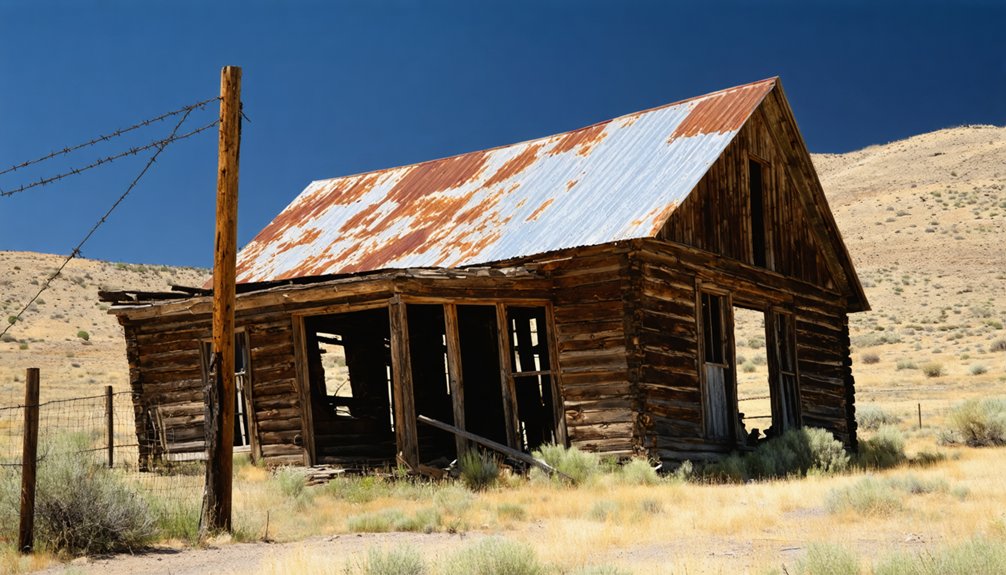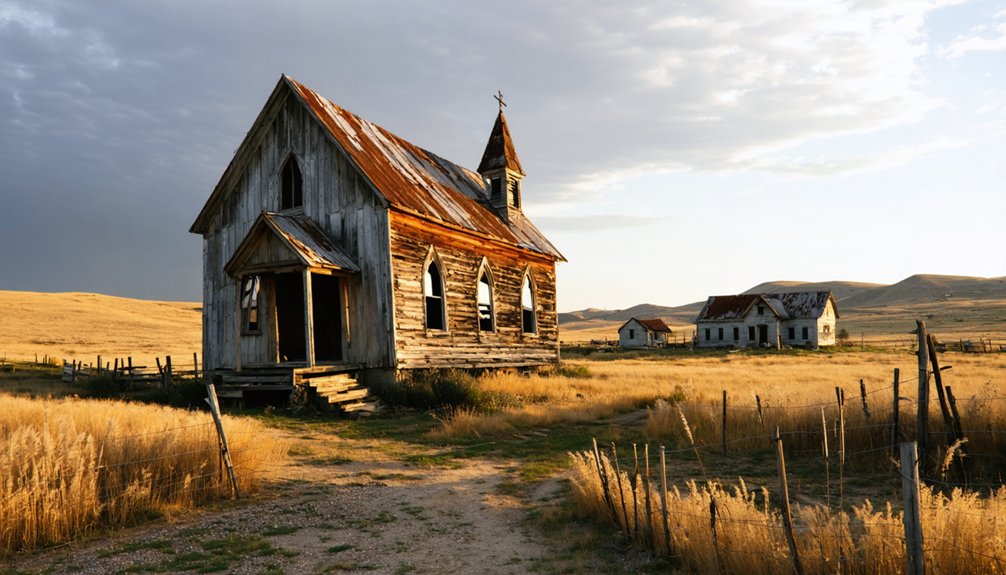You’ll find Dudley nestled in northern Idaho’s panhandle region, where it emerged as a silver mining settlement in 1879. British investment briefly expanded operations to fifty workers in 1881, leading to approximately $2.6 million in total production. The town’s prosperity faded due to unpaid workers, regulatory costs, and declining ore quality. Today, scattered foundations and overgrown pathways through pine forests tell the story of this once-bustling mining community’s dramatic rise and fall.
Key Takeaways
- Dudley was a mining town established in 1879, located 7 miles south of Cataldo in northern Idaho’s panhandle region.
- The town’s mining operations produced approximately $2.6 million in minerals before declining due to economic challenges and low-grade ore.
- Remote location, high shipping costs, and declining mineral prices contributed to the town’s eventual abandonment.
- Historic remnants include building foundations, cellar holes, and an old hotel that symbolizes the community’s mining heritage.
- Pine forests and mountain terrain have reclaimed much of Dudley’s infrastructure, though preservation efforts continue through local organizations.
The Rise and Fall of Dudley’s Mining Era
While mining operations in Dudley, Idaho began modestly with a ten-stamp mill in 1879, the town’s trajectory changed considerably with British investment in 1881, which temporarily expanded the workforce to fifty men.
You’ll find that this initial promise quickly soured when the British company failed to pay its workers, leading to the first of many operational shutdowns.
Despite advances in mining technology, including an upgrade to a thirty-stamp mill in 1895, historical disputes and financial troubles plagued the district.
The mine’s total production reached approximately $2,000,000 by the early 20th century, with an additional $600,000 added through later operations.
Though you’d see periodic revivals in 1906 and 1907, the shift to lower-grade ores and ongoing legal battles ultimately sealed Dudley’s fate as another boom-and-bust mining town.
Life in Early Dudley Settlement
Though records of early life in Dudley remain sparse, you’ll find that the settlement emerged as a typical mining community 7 miles south of Cataldo, where families clustered their homes near the mines for convenience.
Like other mining towns of its era, Dudley’s daily rhythms centered around the demanding work schedules of the mines, with family dynamics shaped by the industry’s needs. Similar to how Wikipedia employs place name disambiguation to avoid confusion with other locations, residents had to be clear about which Dudley they meant when corresponding with outsiders. The community faced challenges similar to Dudleytown, Connecticut, where the lack of stores and schools meant residents had to travel to nearby towns for basic provisions.
You’d have witnessed a close-knit society where community gatherings served as essential breaks from the rigors of mining life. The old hotel, which stood as the last remaining structure, likely served as a hub for social activities.
While specific details about Dudley’s population and services aren’t well documented, you can imagine the resourceful spirit of residents who created a life amid the challenges of frontier mining.
Geographic Features and Natural Surroundings
You’ll find Dudley nestled in a mountain valley of northern Idaho’s panhandle region, where the terrain consists of rolling hills covered in mixed coniferous forests.
The surrounding landscape bears the marks of historic mining activity, characteristic of Shoshone County’s rich mineral heritage. Similar to Connecticut’s Dark Haunted Town, the area has been abandoned since its early settlement period. The area’s mining legacy resembles that of Bonanza, which thrived after gold was discovered in 1877.
The natural setting includes both gentle slopes and steeper hillsides, with an elevation typical of settlements in the Coeur d’Alene River watershed.
Mountain Valley Setting
Due to limited historical records and documentation, specific details about Dudley’s mountain valley setting and natural surroundings remain largely unknown.
While the area’s coordinates appear on the Rose Lake USGS map, there’s insufficient data to accurately describe the mountain climate or valley ecosystem that once characterized this Idaho ghost town’s environment.
You’ll find that Dudley’s precise natural features, including its elevation, surrounding peaks, vegetation, and waterways, aren’t well-documented in available historical sources.
Located 7 miles south of Cataldo, the town occupied a remote position in Idaho’s mountainous terrain.
Like many mining settlements that dotted Idaho’s landscape, Dudley was positioned in terrain suitable for mineral extraction.
Without verifiable research materials, it wouldn’t be accurate to make assumptions about the specific geographical elements that defined this settlement’s mountain valley location.
The lack of surviving records leaves much of Dudley’s physical setting to speculation, making it challenging to paint a detailed picture of its natural landscape.
Mining Land Features
The rich geological features around Dudley shaped its mining legacy, with extensive silver and galena ore deposits embedded within complex fault systems.
You’ll find massive ore lenses stretching up to 90 feet long and 14 feet thick, though the notorious “pinch and swell” effect made ore extraction challenging.
The surrounding geological formations include dense forests that provided essential timber for mining operations. The local mines reached their peak in War Eagle Mountain, where significant silver and gold deposits were first discovered in 1862.
Today’s adventurers can explore these features while following historic hiking trails, connecting to the region’s rich mining heritage.
Key features you’ll encounter while exploring Dudley’s mining landscape:
- Deep mining shafts extending beyond 500 feet, following ore veins until they terminate at major fault zones
- Rocky outcrops and exposed quartz veins that attracted early prospectors
- Mountain ridges and valleys containing both primary ore deposits and placer accumulations from upstream erosion
Economic Forces Behind Dudley’s Abandonment
Dudley’s economic downfall began with its overwhelming reliance on the timber industry, which faced multiple challenges including resource depletion, technological changes, and market volatility.
You’ll find that the town’s remote location and poor transportation infrastructure compounded these issues, making it increasingly difficult for local mills to compete with larger operations in more accessible areas.
The resulting job losses triggered a mass exodus of workers and their families, creating a devastating ripple effect that ultimately transformed Dudley into a ghost town. Similar to many Idaho towns established in the late 19th century, Dudley struggled to maintain its economic viability as industries evolved. Like other Idaho communities facing industrial decline, the town experienced severe lead contamination from nearby mining activities, further complicating its economic recovery efforts.
Mining Industry’s Rapid Decline
While mining operations initially flourished in central Idaho’s mineral-rich terrain, a perfect storm of economic challenges hastened Dudley’s demise in the late 19th century.
The region’s complex geology made ore extraction increasingly difficult and costly, with unpredictable “pinch and swell” structures frustrating even experienced miners.
You’ll understand the magnitude of these challenges through three critical factors:
- Geological challenges like the Rockwell and Minnie faults repeatedly halted production, requiring massive capital investment.
- The Philadelphia smelter’s closure in 1888 forced miners to ship ore to distant facilities at $10+ per ton.
- Market volatility in lead and silver prices made long-term planning nearly impossible.
These combined pressures transformed once-profitable mines into economic burdens, ultimately sealing Dudley’s fate as mining operations became unsustainable.
Regional Economic Ripple Effects
As mining operations crumbled in Dudley during the late 19th century, devastating ripple effects spread throughout the region’s interconnected economic fabric.
You’ll find that supporting industries, from blacksmiths to supply stores, quickly shuttered their doors as the mining workforce dispersed. The town’s attempts at economic diversification were thwarted by deteriorating infrastructure and shifting transportation routes that favored nearby communities like Cataldo.
The demographic changes proved particularly damaging, as skilled workers and their families sought opportunities elsewhere. This exodus created a downward spiral: fewer residents meant less consumer spending, leading to more business closures and job losses.
Rising operational costs from new mining regulations, coupled with inadequate rural development incentives, sealed Dudley’s fate as its economic foundation continued to erode.
Labor Force Migration Pattern
Labor migration patterns in the late 1800s painted a stark picture of economic decline in Dudley, driven by the systematic exodus of miners and support workers seeking stable employment elsewhere.
The town’s isolation and dependence on resource extraction made it particularly vulnerable to labor mobility trends and wage disparities between regions.
You’ll find three key factors that accelerated Dudley’s workforce exodus:
- Resource depletion in local mines created unsustainable employment conditions
- Growing wage disparities between Dudley and emerging industrial centers
- Development of new transportation infrastructure that made it easier for workers to relocate
These migration patterns reflected broader economic forces of the era, where workers increasingly moved toward areas offering diverse employment opportunities and higher wages, leaving remote, single-industry towns like Dudley struggling to maintain their workforce.
Preservation Efforts and Historical Legacy
Since the decline of Idaho’s mining era, preservation organizations have worked tirelessly to protect ghost towns like Dudley from disappearing entirely.
You’ll find the Lemhi County Historical Society and U.S. Forest Service leading efforts to maintain these historic sites, though they face significant preservation challenges including environmental degradation from past mining activities and ongoing vandalism concerns.
The historical significance of Dudley extends beyond its physical structures – it’s a tangible connection to Idaho’s mining heritage and pioneer life.
Through educational programs and guided tours, you’re able to explore the architectural remnants and mining infrastructure that tell the story of boom-and-bust cycles.
While financial constraints and resource limitations affect preservation work, dedicated private owners and community groups continue investing their time and resources to protect these invaluable pieces of Western history.
Exploring Dudley’s Remaining Structures

The old hotel stands as Dudley’s last tribute to its once-thriving mining community, weathered but defiant against time and elements. Its deteriorating hotel architecture offers a rare glimpse into the town’s bygone era, while the adjacent cemetery significance reveals the human stories etched in weathered headstones and overgrown plots.
As you explore Dudley’s remaining landscape, you’ll discover:
- Scattered building foundations and cellar holes that map the town’s original footprint
- Crawl spaces and built-in features showcasing early 20th-century construction methods
- Original pathways, now veiled by sagebrush, connecting the hotel to former commercial districts
The surrounding pine forests and mountain terrain have gradually reclaimed much of Dudley’s infrastructure, leaving the hotel as the sole sentinel of this once-bustling mining settlement.
Frequently Asked Questions
Are There Any Documented Paranormal Activities or Ghost Sightings in Dudley?
Like a blank canvas untouched by spirits, you won’t find documented ghost encounters or spectral evidence in Dudley, Idaho. Unlike its Connecticut namesake, this ghost town holds no paranormal reputation.
What Happened to the Personal Belongings of Dudley’s Last Residents?
You’ll find that most abandoned artifacts were either scavenged, decayed naturally, or taken by trespassers. While local folklore suggests some belongings remain scattered in ruins, no formal documentation exists.
Did Any Famous Historical Figures Ever Visit Dudley?
Like a forgotten footprint in desert sand, you won’t find any famous visitors in Dudley’s history. Historical records don’t show any significant figures stopping by this small, isolated mining settlement.
Were There Any Notable Crimes or Lawless Incidents in Dudley?
You won’t find documented records of significant criminal activity or law enforcement incidents in Dudley. Unlike its Connecticut namesake, this Idaho ghost town’s history reflects typical mining settlement patterns without notable lawlessness.
Did Native American Tribes Have Settlements Near Dudley Before Mining Began?
You’ll find that Shoshone-Bannock tribes maintained native settlements near this area, using the fertile valleys for hunting and seasonal camps. Their cultural significance included established villages and extensive traditional land knowledge.
References
- https://www.ghosttowns.com/states/id/dudley.html
- https://en.wikipedia.org/wiki/Dudleytown
- https://www.americanhauntingsink.com/dudleytown
- https://visitidaho.org/things-to-do/ghost-towns-mining-history/
- https://usghostadventures.com/haunted-stories/americas-most-haunted-east/the-curse-of-dudleytown/
- https://history.idaho.gov/wp-content/uploads/2018/08/0064.pdf
- https://www.thegoldminehotel.com/ghost-towns-and-haunted-places-in-idaho
- https://en.wikipedia.org/wiki/List_of_ghost_towns_in_Idaho
- https://www.onlyinyourstate.com/experiences/connecticut/dudleytown-ct
- https://history.idaho.gov/wp-content/uploads/2018/08/0009.pdf



